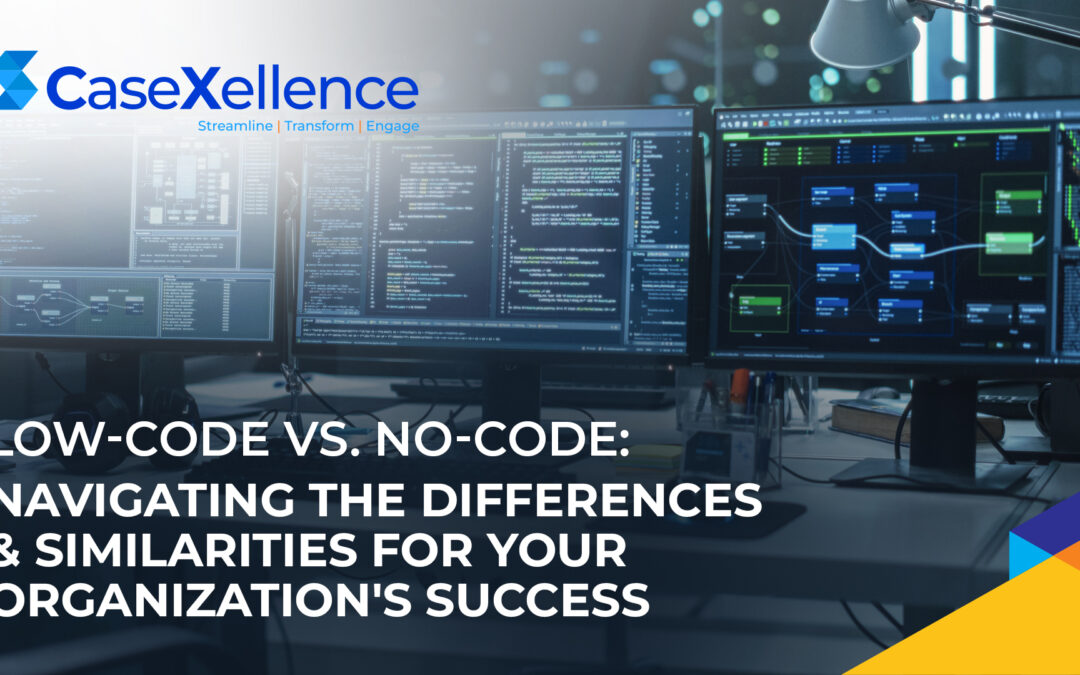The rapid advancement in technology, particularly in software development, has offered us a paradox of choice when it comes to determining the most appropriate platform for application creation. Amidst this sea of options, two platforms, Low-Code and No-Code, have stood out, gaining a significant following due to their agility and efficiency. This blog post will delve into the world of Low Code No Code Platforms, highlighting their differences, and similarities, and how to choose the right solution for your organization. We’ll also touch upon Speridian Technologies’ low-code platform, CaseXellence, and how it caters to both government agencies and private companies alike.
Table of Contents
Low-Code and No-Code: What Are They?
At their cores, both Low-Code and No-Code platforms aim to democratize application development by minimizing the traditional coding required.
Low-Code
As the name implies, Low-Code platforms reduce the amount of manual coding necessary to develop applications. They provide a visual development environment where users can drag-and-drop application components, design interfaces, and stitch together workflows. While Low-Code simplifies the development process, it doesn’t entirely eliminate the need for coding. Skilled developers can fine-tune applications with custom code, allowing a greater degree of flexibility and customization.
No-Code
No-Code platforms take this concept a step further by completely eliminating the need for manual coding. They leverage a similar visual interface to Low-Code but are designed to allow non-technical users to build applications. With No-Code platforms, you can quickly turn business ideas into functional applications without a need for developer intervention.
Similarities and Differences
Similarities
Both platforms serve the same goal – to expedite and simplify the application development process. They feature drag-and-drop interfaces and pre-built templates that enable rapid application development and deployment. Furthermore, both Low-Code and No-Code platforms foster better collaboration between IT and business teams, enabling faster and more efficient responses to business needs.
Differences
The main difference lies in the level of customization and complexity of applications that can be created. Low-Code platforms, while simplifying the development process, still allow for custom coding. This is ideal for more complex applications where greater flexibility and customization are required. Conversely, No-Code platforms are perfect for simpler applications, where speed and ease of use are more important than extensive customization.
Choosing the Right Platform: Low-Code or No-Code?
Determining the right platform depends on various factors such as the complexity of the project, the technical skill level of your team, and the time available for application development.
If your organization has complex application needs, or if you have a team of developers who can exploit the customization possibilities, a Low-Code platform is the best choice. For projects that require rapid turnaround, or in organizations where the users are primarily business users with little to no programming skills, No-Code platforms are the more suitable choice.
The Best of Low-Code: Speridian Technologies’ CaseXellence
If your organization is leaning towards a Low-Code solution, look no further than CaseXellence from Speridian Technologies. Recognized for its high degree of customizability, agility, and scalability, CaseXellence is a Low-Code platform that caters to both government agencies and private companies.
CaseXellence accelerates application delivery by offering a comprehensive suite of pre-built components and an intuitive visual interface. It provides the perfect balance of structure and flexibility, allowing developers to create applications quickly while still maintaining the freedom to write custom code when needed.
Whether it’s managing complex workflows, integrating with legacy systems, or ensuring compliance with industry-specific regulations, CaseXellence has proven to be an ideal solution. By choosing CaseXellence, you are choosing a platform that combines speed, power, and customization, thereby enabling your organization to respond swiftly and effectively to ever-evolving business needs.
In conclusion, both Low-Code and No-Code platforms have their unique strengths and are crucial tools for modern software development. Understanding their differences and similarities can help you make an informed decision on which one to choose. Ultimately, the choice between Low-Code and No-Code will depend on your organizational needs, technical resources, and strategic goals. Regardless of the path you choose, platforms like CaseXellence ensure that you are well-equipped to navigate the fast-paced world of application development.
Related Blogs
No-code, no problem: How low-code/no-code tools are driving IT innovation
Why Do Organizations Need To Go Digital With Case Management Systems?
Case Management Solutions: Increasing Productivity And Agility For All Sectors





